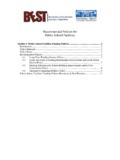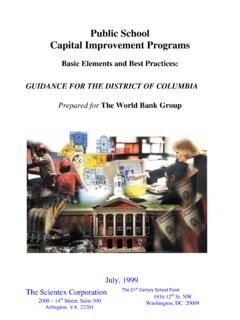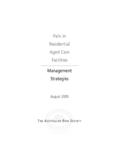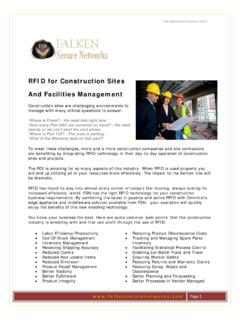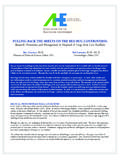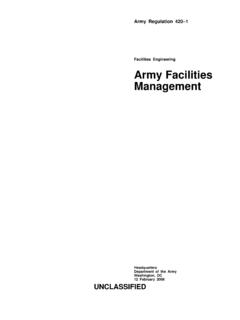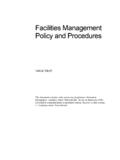Transcription of Recommended Policies for Public School Facilities
1 Recommended Policies for Public School Facilities Section 3: Public School Facilities management Policies .. 2 2 Policy Rationale .. 4 Policy Intent .. 5 Recommended Policies .. 5 Statewide School Facility Inventory 5 Minimum Adequacy Standards Policy .. 6 Environmental Design and Construction Practices Policy .. 7 Maintenance Criteria and Evaluation Policy .. 8 Taxpayer Investment Protection Policies & Procedures Policy .. 10 Public School Facilities management Policies Resources & Best Practices.
2 12 BEST Collaborative Section 3: Facilities management - May 2005 2 Section 3: Public School Facilities management Policies Introduction It is the responsibility of each state to ensure that every child has access to a quality education. In many states, the courts have determined that School Facilities that provide educational settings suited to the state s determined curriculum are a significant part of this responsibility. However, School facility management and construction have traditionally been entirely the responsibility of the School district.
3 Many states, particularly those who have increased their funding to local School districts are putting in place Policies , procedures and technical assistance to ensure that their Public School Facilities are educationally adequate. The purpose of this paper is to provide policy guidance and recommendations to elected and appointed officials and administrators at the State, local, and School district level to improve Facilities management in order to support and enhance the delivery of educational programs and services for students and teachers.
4 The implementation of Policies that result in high quality, high-performing, well designed and maintained School Facilities has a direct and indirect impact on the teaching and learning process. Effective Facilities management can contribute to the success of every student in every School in the United States. In 2001, led by the 21st Century School Fund (21 CSF), and supported by the Ford Foundation, a group of very experienced School facility and community-based groups came together in a collaboration called BEST (Building Educational Success Together).
5 The BEST partners are: 21 CSF; the Education Law Center (Newark, NJ); Neighborhood Capital Budget Group (Chicago, IL); the Knowledgeworks Foundation (Cincinnati, OH); The National Trust for Historic Preservation (Washington, DC); the National Clearinghouse for Educational Facilities (Washington, DC), New Schools Better Neighborhoods (Los Angeles, CA), New Visions for Public Schools (New York, NY), and Mark Schneider (State University of New York at Stony Brook). The BEST partners developed a four-part policy agenda: 1) Increase Public participation in Facilities planning, 2) create and support schools as centers of community that offer School -based supports to children to eliminate barriers to success and serve the broader community, 3) improve Facilities management , including maintenance and capital improvement programs and 4) secure adequate and equitable Facilities funding.
6 We have developed Recommended School facility Policies in these four areas. This paper is the third part of an effort to address our four-part policy agenda. State policy reform is one tool for affecting the planning, design, construction, maintenance and funding practices and processes at the state and local School district levels. However, state level standards and control must be carefully developed and applied, so that creativity, Public participation, and local priorities can drive the facility planning and design outcomes.
7 BEST Collaborative Section 3: Facilities management - May 2005 3 These School Facilities Policies may be used to: assess your state and local Policies compare these Recommended Policies to your state and School district s Policies ; facilitate a discussion among teachers, parents, students, principals, facility managers, community and business leaders, about any policy barriers to well-maintained, educationally adequate School Facilities ; identify policy or funding incentives that can be adopted to support high quality educational Facilities for all children.
8 And build consensus for state level mandates that require local School districts to engage in best practice for School facility condition, design and utilization. We hope that others will correspond with us, critique our work, offer suggestions, substitutions or additions to any or all areas. We also hope that we will receive accounts of successes or failures in using or implementing the Policies or elements at any level. BEST Collaborative Section 3: Facilities management - May 2005 4 Policy Rationale It is the legal and moral responsibility of each state to ensure that every child has access to a quality education.
9 In many states, the courts have determined that the ability of School Facilities to meet a standard of educational adequacy, that is to provide an educational setting that allows the state s determined curriculum to be taught, is a significant part of this responsibility. To meet this goal, each state needs to know the condition of their School Facilities , and the elements and determining factors in meeting the state s educational curriculum or outcomes. The state should measure these factors against one another to determine each facility s education adequacy.
10 It should then ensure that Facilities that do not meet these standards are brought up to an acceptable level. Districts or localities without the financial resources to bring their School Facilities up to the state standard should be assisted so that the standard is consistently met across the state. This requires a significant amount of managerial skill and coordination between and among the state and the districts or localities. When substantial Public investment is made in Facilities , their maintenance and upkeep are in the Public interest.
